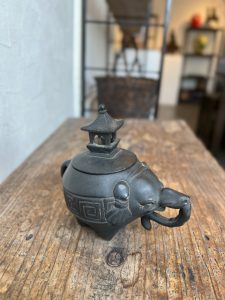「蘭奢待」の拝見、やり直ししたいです。(愛知県名古屋市千種区姫池通 骨董買取 古美術風光舎)
2023.11.23
みなさまこんにちは、スタッフYでございます。

いいお天気ですね。本日も東山の紅葉の中を走り抜けて通勤してまいりました。通り抜ける際に、朝日がちょうど紅葉を照らし出し、ぱっと色鮮やかな紅葉が目の前にあらわれ大変気持ちのいい通勤でありました。今朝のTVでも京都の清水寺のライトアップの様子を見ておりましたが、あまりの人の多さにちょっと近づける感じではありませんでしたが、暗闇の中ライトアップが点灯し、TV越しではありますが圧巻でありましたね。
さてさて、昨日なのですがTVにて「蘭奢待」を取り上げておりまして大変面白かったです。
「蘭奢待」について以前HPにて呟いたことがあったのですが、それにしても「名香」こそ歴史的に有名な宝物を前にし、その価値たるは何ぞや?と最も自分を試されている気がしてなりません。要するに、知識予習をしたためて臨みませんと、何も知らない状態で「黒焦げた木」を前に、スルーするのみといった残念なことが起こりかねないのです。
「蘭奢待」はありがたいことに、たしか4年位前に一度実際に拝見するチャンスがありまして。
しかし、あまり知識もなく有名な武将や天皇が取りだした切口を眺め「すごい」ことはわかったのですが、先日のTVを見てからあの名香を拝見したのなら、大きな黒焦げた木を前に、にわかですが知識や情報というフィルター越しに想像力を奮い立たせ、この名香越しにみえてくる歴史な景色がもっと実感できたのにな…。と、今になって後悔が増してきます。
歴史的に有名なものを拝見する際には、せっかくのチャンスを大切にするべく知識は少しでもしたためていかねば、と、昨日は本当に思いました。
私の後悔はいったん置いておくとして、そんなことよりも、「蘭奢待」のその価値は歴史的背景もさることながら、その「名物の香」として香木そのものも由緒正しく、香りとしても最上級の価値があるようです。歴史の行方をも左右するほどの香り、いったいどんなものなのでしょうか。
先日のTVですと、しばしば、数々の名香を数で区切って、佐々木道誉の百八十種名香や、山上宗二の十種名香のように○○種名香と呼ばれることがあるのですが、その中でも、足利義政の命により、志野流香道の始祖である志野宗信、御家流香道三条西実隆が選んだといわれるのが「六十一種名香」。
六十一種の名香は、選ばれた現在も伝わっている香木でして、その中に法隆寺(全浅香)、東大寺(蘭奢待)などが筆頭に挙げられております。いわれも由緒正しいながら、これらの名香は、伽羅・羅国・真南蛮・真那伽・佐曽羅・寸門陀羅の六つに分類し、さらにその香りを酸(すっぱい)・苦(にがい)・甘(あまい)・辛(からい)・鹹(塩辛い)の五つの味で表現したところ、香木ごとに特徴は違うとは思いますが、すべての香りがこれらに含まれるパーフェクトな香りのようであるようです。
ますます名香の香りが気になりますね。
そんな中、昨年ですが芝の増上寺にて献香式を執りおこなわれたことは記憶に新しく、そこで炷(た)かれるのが、志野流に初代より“家木(かぼく)”として伝わる天下の名香“蘭奢待”でありました。そのお家元の、香りを聞いた蜂谷宗玄氏によりますと「今の自分ではなんとも言いあらわせれない重厚な香りですので、30年後にもう一度訪ねてほしい。」とのことでした。
蘭奢待がこれまでたどってきた1000年以上の歳月とそのパーフェクトな香りを形容するには聞く側にもそれを受け止める器が必要になってくるということなのでしょうか。
なにせ、足利義政や織田信長が聞いた同じ香りなのですから、私が仮にも香りを聞くことが出来たのなら、想像力が増し増しで間違いなく普通のメンタルではなく、聞くどころではなくなりそうですね。
それでは、ごきげんよう。

Hello everyone, this is Staff Y.
It’s a beautiful day, isn’t it? Today, I drove through the autumn leaves in the Higashiyama area on my way to work. The morning sun was shining on the leaves as I passed by, and it was a pleasant morning. This morning, I saw the lighting up of Kiyomizu-dera Temple in Kyoto on TV. There were so many people that I could not get close to the temple, but the lights came on in the darkness, and it was breathtaking, even through the TV.
Yesterday, the TV program “Lanjiajitai” was featured on TV, and it was very interesting.
I have already muttered about “Lanjatai” on my homepage before, but I felt that “Meika” was a historically famous treasure in front of me, and I wondered what was the value of it. I felt like I was being tested the most. In short, if you do not go to the exhibition with a thorough knowledge of the subject, you may be disappointed to find that you can only pass by the “blackened wood” in front of you without knowing anything about it.
Thankfully, I had a chance to see “Lanjitie” in person about four years ago.
However, if I had seen the famous fragrance after watching the TV program the other day, I would have been able to see the big black charred tree, and my imagination would have been stimulated through the filter of knowledge and information, and I would have been able to feel the historical view through this famous fragrance more. I would have been able to experience more of the historical scenery through the Meika…. I regret that I did not have the chance to see the famous historical sites. Yesterday, I really thought that I should have made the most of the opportunity to visit famous historical sites by learning as much as I could about them.
Putting my regrets aside for the moment, the value of “Lanjatai” is not only its historical background, but also the fragrance of the tree itself, which is a “famous fragrance” with a venerable history and the highest value as a scent. What kind of fragrance is this that can even influence the course of history?
According to the TV program that I saw the other day, many famous fragrances are often divided by numbers and called “XX kinds of famous fragrances,” such as 180 kinds of famous fragrances by Sasaki Doyo and 10 kinds of famous fragrances by Yamagami Soji. The 61 great fragrances were selected by Shino Munenobu, the founder of the Shino school of kodo, and Sanenishi Sanetaka, the founder of the Oke school of kodo.
The 61 famous fragrances are fragrant woods that are still handed down today, and among them, Horyuji Temple (Zen Asaka) and Todaiji Temple (Ranjatai) are listed at the top of the list. The fragrances are classified into six categories: Kyara, Raguo, Shinanban, Managa, Sasora, and Sumondara, and the fragrances are expressed in terms of five tastes: sour, bitter, sweet, spicy, and salty. Although the characteristics of each fragrant tree may differ, it seems that all fragrances have a perfect aroma that includes these five tastes.
I am becoming more and more interested in the fragrance of great fragrances.
Last year, Zojoji temple in Shiba held an aroma offering ceremony, where they offered the famous aroma “Lanjatai”, which has been handed down in the Shino school as “Kaboku” since the first generation. The aroma was “Ranjatai”, the most famous incense in the world. Sogen Hachiya, who heard the Iemoto’s fragrance, said, “It is a profound fragrance that I cannot describe now, so I would like you to visit again in 30 years. I would like you to visit again in 30 years.
To describe the more than 1,000 years that Lanjatai has been in existence and its perfect fragrance, the listener must have the capacity to receive it.
If I were able to listen to the fragrance, my imagination would be heightened and I would definitely not be able to listen to it with my normal mentality.
So, good day to you.

